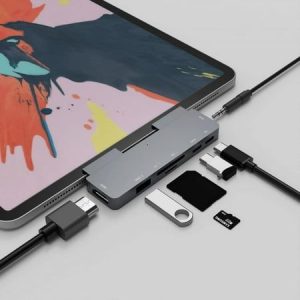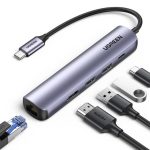Contents
- 1 Why Connect Your iPad to an HDMI Display?
- 2 HDMI to iPad: A Match Made with Adapters
- 3 Adapter Considerations:
- 4 Connecting Your iPad to HDMI: Step-by-Step Guide
- 5 Troubleshooting Tips:
- 6 Beyond Mirroring: Additional Features
- 7 Expanding Your Creative Arsenal
- 8 Mirror or Extend: Choose Your Display Mode
- 9 Controlling Your Display
- 10 HDMI to iPad: Not Just for Home
- 11 Tips for an Optimal HDMI to iPad Experience
- 12 The Future of Connectivity: Beyond HDMI
Why Connect Your iPad to an HDMI Display?
Your iPad isn’t just a pocket-sized powerhouse for productivity; it’s a portable entertainment hub and presentation tool. However, its small screen can sometimes feel limiting. Enter HDMI: the bridge between your iPad and larger displays like TVs, monitors, and projectors. Here’s what you unlock:
- Presentations with Panache: Delivering presentations on a bigger screen makes your content more engaging and easier for your audience to follow.
- Streaming Bliss: Enjoy your favorite movies and shows on a larger display for a cinematic experience.
- Gaming Galore: Project your favorite mobile games for a truly immersive experience.
- Creative Workflows: Extend your digital workspace by mirroring your iPad screen to a larger monitor.
- Family Fun: Share photos and videos on the big screen during gatherings.
HDMI to iPad: A Match Made with Adapters
Let’s get technical! Since iPads don’t have built-in HDMI ports, you’ll need an adapter to make the connection. The type of adapter you need depends on your iPad model:
iPad with USB-C Port:
Look for a USB-C to HDMI adapter. These are typically compact and plug directly into your iPad’s charging port.
iPad with Lightning Port:
You’ll need a Lightning Digital AV Adapter. This adapter features a Lightning connector on one end and an HDMI port on the other.

Adapter Considerations:
- Resolution Support: Most adapters support up to 1080p resolution, but some premium models can handle 4K. Choose the resolution that matches your needs and the capabilities of your display.
- Additional Ports: Some adapters offer extra features like pass-through charging or additional ports for connecting accessories.
- Brand and Quality: Invest in a reputable brand like Apple or a well-reviewed third-party option to ensure compatibility and reliable performance.
Connecting Your iPad to HDMI: Step-by-Step Guide
Let’s walk through the simple process of connecting your iPad to an HDMI device:
- Choose Your Adapter: Based on your iPad model, select the appropriate USB-C to HDMI or Lightning Digital AV Adapter.
- Connect the Adapter: Plug the adapter into your iPad’s charging port.
- Connect the HDMI Cable: Connect one end of an HDMI cable to the adapter and the other end to the HDMI port on your TV, monitor, or projector.
- Switch Input: Change the input source on your display to the corresponding HDMI port.
- Enjoy the Show! Your iPad screen should now be mirrored on the larger display.

Troubleshooting Tips:
- No Signal: Ensure all connections are secure and your display is set to the correct HDMI input. If you’re using a powered adapter, make sure it’s plugged in.
- Black Screen: Try restarting your iPad and the display. If the issue persists, check for software updates or try a different HDMI cable.
- Distorted Image: Ensure the resolution settings on your iPad and display are compatible.
- Audio Issues: Check the volume settings on both your iPad and the display. If using an external sound system, ensure it’s connected properly.
Beyond Mirroring: Additional Features
HDMI adapters offer more than just screen mirroring. Explore these additional possibilities:
- Dual-Screen Setup: Some adapters allow you to use your iPad as a second display while extending your workspace.
- Video Output: Play movies or videos stored on your iPad on the big screen with full audio and video support.
- Presentation Mode: Optimize your presentations with features like presenter notes and slide control directly on your iPad.
- App Compatibility: Many apps, such as Netflix, YouTube, and Keynote, support HDMI output, allowing you to enjoy them on a larger display.

Expanding Your Creative Arsenal
Artists, musicians, and content creators can leverage HDMI to iPad connectivity to enhance their workflow. Connect your iPad to a larger monitor for photo or video editing, music production, or even drawing and painting.
Let me know if you’d like any more sections!
Mirror or Extend: Choose Your Display Mode
Depending on your needs, you can either mirror your iPad’s screen to the HDMI display or extend it:
-
Mirroring: Ideal for presentations and watching videos, mirroring shows the exact same content on both your iPad and the larger screen. It’s a simple and straightforward way to share your content.
-
Extending: Perfect for multitaskers, extending your display creates a separate workspace on the HDMI screen. You can have different apps open on each display, maximizing your productivity.

Controlling Your Display
To switch between mirroring and extending modes or to adjust other display settings, follow these steps:
- Connect your iPad to the HDMI display.
- Open the Control Center: Swipe down from the top-right corner of the screen.
- Tap Screen Mirroring: Select the display you want to connect to.
- Choose Display Mode: Tap the display icon again and select either “Mirror” or “Extend.”
HDMI to iPad: Not Just for Home
HDMI to iPad connectivity isn’t limited to home use. It’s a valuable tool for professionals and businesses:
- Education: Teachers can use HDMI to project educational content, interactive lessons, and demonstrations.
- Corporate Presentations: Sales teams can deliver impactful presentations on larger screens.
- Retail Displays: Businesses can showcase product demos, advertisements, or informative videos.
With a portable HDMI adapter, you can transform your iPad into a mobile workstation. Connect it to a monitor and keyboard, and you’re ready to tackle work tasks on the go.
Tips for an Optimal HDMI to iPad Experience
- Cable Quality: Invest in high-quality HDMI cables to ensure the best picture and sound quality.
- Check Compatibility: Verify that your iPad model and iOS version are compatible with the adapter and display.
- Update Software: Keep your iPad’s operating system and apps updated for optimal performance and compatibility.
- Adjust Settings: Experiment with different display settings, such as brightness and contrast, to find what works best for you.
 The Future of Connectivity: Beyond HDMI
The Future of Connectivity: Beyond HDMI
While HDMI is the current standard for connecting your iPad to external displays, emerging technologies like AirPlay and wireless display adapters offer even more flexibility and convenience. Keep an eye on these advancements to stay ahead of the curve.
As technology evolves, so do the ways we connect and interact with our devices. HDMI to iPad connectivity is just one example of how we can harness the power of our mobile devices to create immersive and productive experiences. Whether you’re a movie buff, a gamer, a professional, or simply want to enjoy your iPad on a bigger screen, HDMI opens up a world of possibilities.
I hope this comprehensive guide has demystified the world of HDMI to iPad connectivity. If you have any more questions, feel free to ask!


